
Portuguese Food Recipes (Practice the Imperative Mood)
Today I will bring you a few traditional Portuguese food recipes. You should know that following Portuguese recipes is an excellent way to create exposure and engage with your target language. Accordingly, it’s something motivating and hands-on, which in turn creates great conditions for your brain to learn and retain new knowledge efficiently. Above all, it’s fun to do and leads to delicious results 🙂
Now, following recipes is also a way for you to practice the Imperative Mood (grammar intruding on your culinary delight!), specifically the formal forms. See, in Portuguese, there are different “kinds” of Imperative depending on if you are in a formal or informal context, or if you are speaking to one person or a group of people. But again, recipes will typically expose you to the formal (and singular) type of Imperative.
I hope you enjoy preparing these foods.
Pastel de Nata
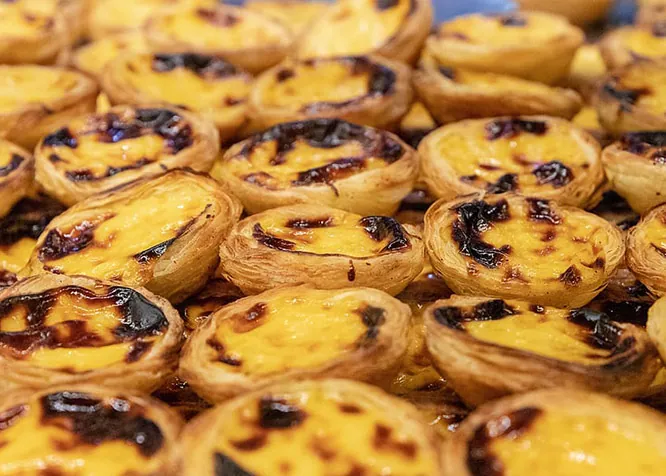
This is a custard tart that is a favorite among Portuguese people and tourists alike. It is made with a flaky pastry crust and a rich, creamy custard filling.
Ingredients
1 cup all-purpose flour
1/2 cup sugar
1/4 cup butter cut into cubes
1/4 teaspoon salt
1 egg yolk
1/4 cup water
1 (14-ounce) can sweetened condensed milk
1/4 cup heavy cream
1 chávena de farinha de trigo
1/2 chávena de açúcar
1/4 de chávena de manteiga cortada em cubos
1/4 colher de chá de sal
1 gema de ovo
1/4 de chávena de água
1 lata de leite condensado adocicado
1/4 de chávena de natas
Instructions
- Preheat the oven to 400 degrees F (200 degrees C).
- In a food processor, pulse together the flour, sugar, butter, and salt until coarse crumbs form.
- In a small bowl, whisk together the egg yolk, water, and condensed milk.
- Gradually add the wet ingredients to the dry ingredients, mixing until a dough forms.
- Press the dough into the bottom and sides of the tart pan.
- Pour the custard mixture into the tart shell.
- Bake for 20 minutes, or until the custard is set.
- Let it cool before serving.
- Pré-aqueça o forno a 400 graus F (200 graus C).
- Num processador de alimentos, bata a farinha, o açúcar, a manteiga e o sal até formar uma textura rugosa.
- Numa tigela pequena, bata a gema de ovo, a água e o leite condensado.
- Adicione gradualmente os ingredientes húmidos aos ingredientes secos e misture até formar uma massa.
- Pressione a massa no fundo e nos lados de uma forma de tarte.
- Deite a mistura de creme na forma de tarte.
- Leve ao forno durante 20 minutos ou até o creme estar firme.
- Deixe arrefecer antes de servir.
Caldo Verde
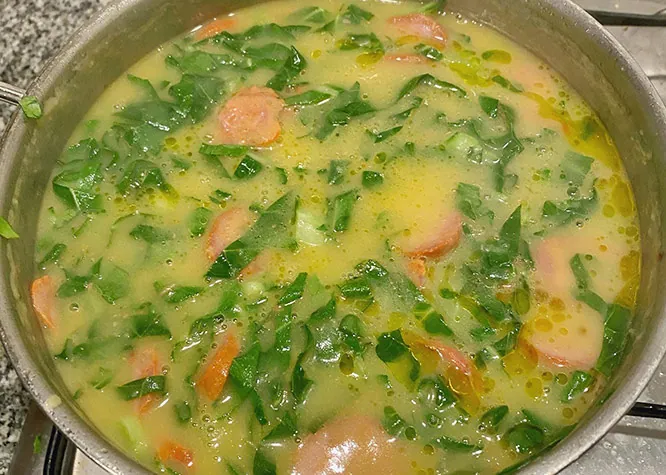
This is a Portuguese soup made with kale, potatoes, and chouriço sausage. It is a hearty and flavorful soup that is perfect for a cold winter day.
Ingredients
1 head of kale, chopped
2 cloves garlic, minced
1/2 cup olive oil
1 pound potatoes, peeled and diced
1 pound chouriço sausage, thinly sliced
4 cups chicken broth
Salt and pepper to taste
1 cabeça de couve cortada
2 dentes de alho, picados
1/2 chávena de azeite
1 kg de batatas, descascadas e cortadas em cubos
450 g de chouriço, cortado em fatias finas
4 chávenas de caldo de galinha
Sal e pimenta a gosto
Instructions
- In a large pot, heat the olive oil over medium heat.
- Add the garlic and cook for 30 seconds, or until fragrant.
- Add the kale and cook for 5 minutes, or until wilted.
- Add the potatoes and chouriço sausage and cook for 5 minutes, or until the potatoes are tender.
- Add the chicken broth and bring to a boil.
- Reduce heat and simmer for 20 minutes, or until the soup is thickened.
- Season with salt and pepper to taste.
- Serve hot.
- Numa panela grande, aqueça o azeite em lume médio.
- Adicione o alho e cozinhe durante 30 segundos, ou até ficar perfumado.
- Adicione a couve e cozinhe durante 5 minutos, ou até ficar murcha.
- Adicione as batatas e o chouriço e cozinhe durante 5 minutos, ou até as batatas estarem tenras.
- Adicione o caldo de galinha e deixe ferver.
- Reduza o lume e deixe cozinhar em lume brando durante 20 minutos, ou até a sopa engrossar.
- Tempere com sal e pimenta a gosto.
- Sirva quente.
Amêijoas à Bulhão Pato
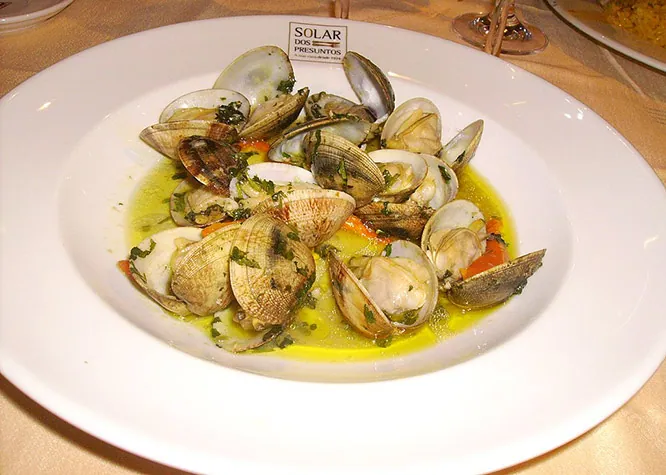
This is a Portuguese dish of clams cooked in white wine, garlic, and parsley. It is a simple but delicious dish that is perfect for a light meal.
Ingredients
2 pounds clams, scrubbed and debearded
1/2 cup olive oil
4 cloves garlic, minced
1/4 cup white wine
1/4 cup chopped fresh parsley
Salt and pepper to taste
900g de amêijoa bem limpas
1/2 chávena de azeite
4 dentes de alho, picados
1/4 de chávena de vinho branco
1/4 de chávena de salsa fresca picada
Sal e pimenta a gosto
Instructions
- Rinse the clams in cold water and pat them dry.
- In a large skillet, heat the olive oil over medium heat.
- Add the garlic and cook for 30 seconds, or until fragrant.
- Add the clams and cook for 3-5 minutes, or until they open.
- Add the white wine, parsley, salt, and pepper to taste.
- Cover and cook for 5 minutes, or until all the clams have opened.
- Discard any clams that do not open.
- Serve immediately with crusty bread for dipping.
- Lave as amêijoas em água fria e seque-as.
- Numa frigideira grande, aqueça o azeite em lume médio.
- Adicione o alho e cozinhe durante 30 segundos, ou até ficar perfumado.
- Adicione as amêijoas e cozinhe durante 3-5 minutos, ou até abrirem.
- Adicione o vinho branco, a salsa, o sal e a pimenta a gosto.
- Tape e cozinhe durante 5 minutos ou até que todas as amêijoas se tenham aberto.
- Deite fora as amêijoas que não abrirem.
- Sirva imediatamente com pão estaladiço para acompanhar.
Bacalhau à Gomes de Sá
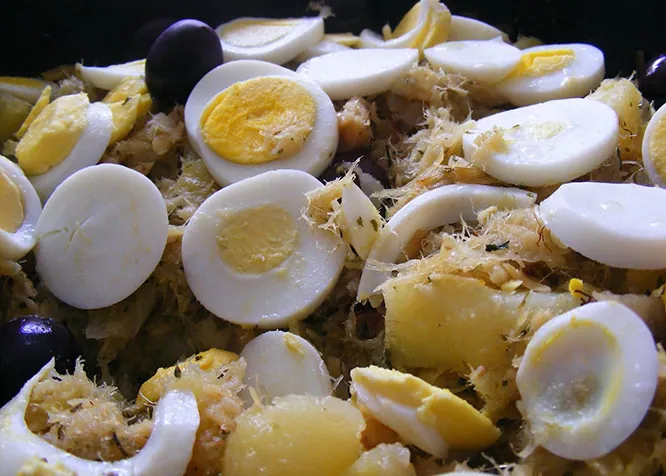
This is a traditional Portuguese dish of salted cod, potatoes, onions, and eggs baked in a dish. It is a hearty and flavorful dish that is perfect for a cold winter day.
Ingredients
2 pounds salted cod, soaked in water for 24 hours and then drained
2 pounds potatoes, peeled and thinly sliced
2 cups chopped onions
6 eggs
1/2 cup olive oil
Salt and pepper to taste
900g de bacalhau salgado, demolhado em água durante 24 horas e depois escorrido
900g de batatas, descascadas e cortadas em rodelas finas
2 chávenas de cebolas picadas
6 ovos
1/2 chávena de azeite
Sal e pimenta a gosto
Instructions
- Preheat the oven to 350 degrees F (175 degrees C).
- Place the cod in a baking dish.
- Top with the potatoes, onions, and eggs.
- Drizzle with olive oil.
- Season with salt and pepper to taste.
- Bake for 1 hour, or until the potatoes are tender and the eggs are set.
- Pré-aqueça o forno a 175 graus C.
- Coloque o bacalhau num prato de ir ao forno.
- Cubra-o com as batatas, as cebolas e os ovos.
- Regue com azeite.
- Tempere com sal e pimenta a gosto.
- Leve ao forno durante 1 hora, ou até as batatas estarem tenras e os ovos firmes.
Leitão Assado
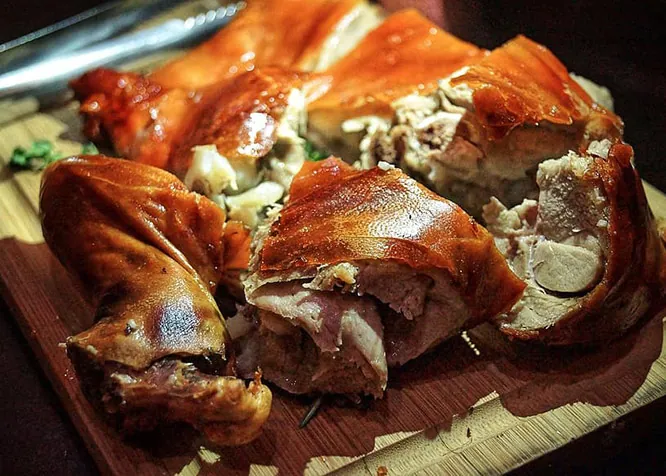
This is a traditional Portuguese dish of roasted suckling pig. It is a popular dish at celebrations and special occasions.
Ingredients
1 whole suckling pig (about 4 pounds)
1/2 cup olive oil
1/4 cup red wine vinegar
4 cloves garlic, minced
1 tablespoon dried oregano
1 tablespoon salt
1/2 teaspoon black pepper
1 leitão inteiro (cerca de 1 kg)
1/2 chávena de azeite
1/4 de chávena de vinagre de vinho tinto
4 dentes de alho picados
1 colher de sopa de orégãos secos
1 colher de sopa de sal
1/2 colher de chá de pimenta preta
Instructions
- Rinse the pig and pat it dry.
- In a small bowl, whisk together the olive oil, red wine vinegar, garlic, oregano, salt, and pepper.
- Rub the marinade all over the pig.
- Let the pig marinate for at least 30 minutes, or up to overnight.
- Preheat the oven to 400 degrees F (200 degrees C).
- Place the pig in a roasting pan and roast for 2-3 hours, or until the skin is crispy and the pig is cooked through.
- Let the pig rest for 10 minutes before carving.
- Lave o porco e seque-o.
- Numa tigela pequena, misture o azeite, o vinagre de vinho tinto, o alho, os orégãos, o sal e a pimenta.
- Pincele a marinada em todo o porco.
- Deixe o porco marinar durante, pelo menos, 30 minutos ou até de um dia para o outro.
- Pré-aqueça o forno a 200 graus C.
- Coloque o porco numa assadeira e asse durante 2-3 horas, ou até a pele ficar estaladiça e o porco estar cozinhado.
- Deixe o porco descansar durante 10 minutos antes de o cortar.

Olá! I'm Pedro and I'm your Portuguese teacher.
Ready to unlock the beauty of European Portuguese? Portuguesepedia is your key! This all-in-one platform provides a wealth of learning resources, from bite-sized video lessons to immersive idiomatic dips. Perfect your pronunciation and aural comprehension with listening drills and solidify your grammar with in-depth articles. Start your Portuguese journey today!
Share this article
Get my guide "Key Strategies to Learn Portuguese" for FREE.
